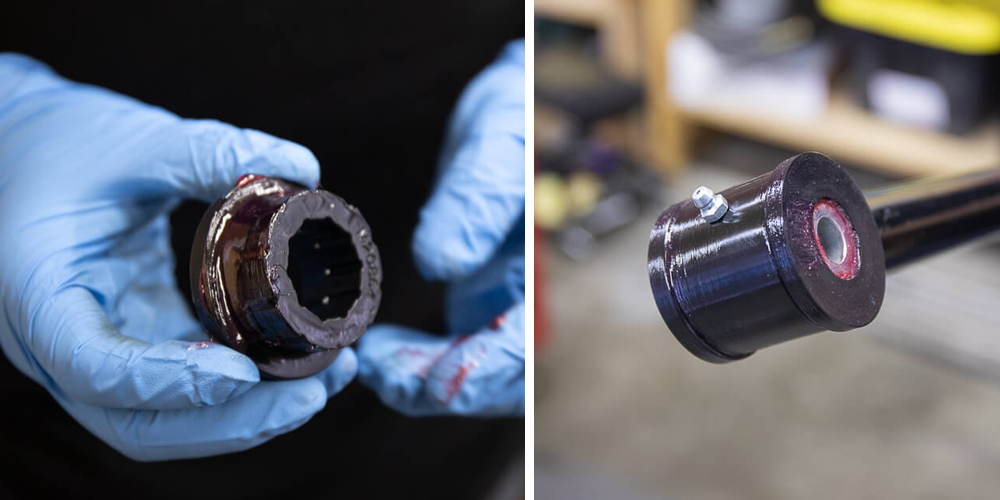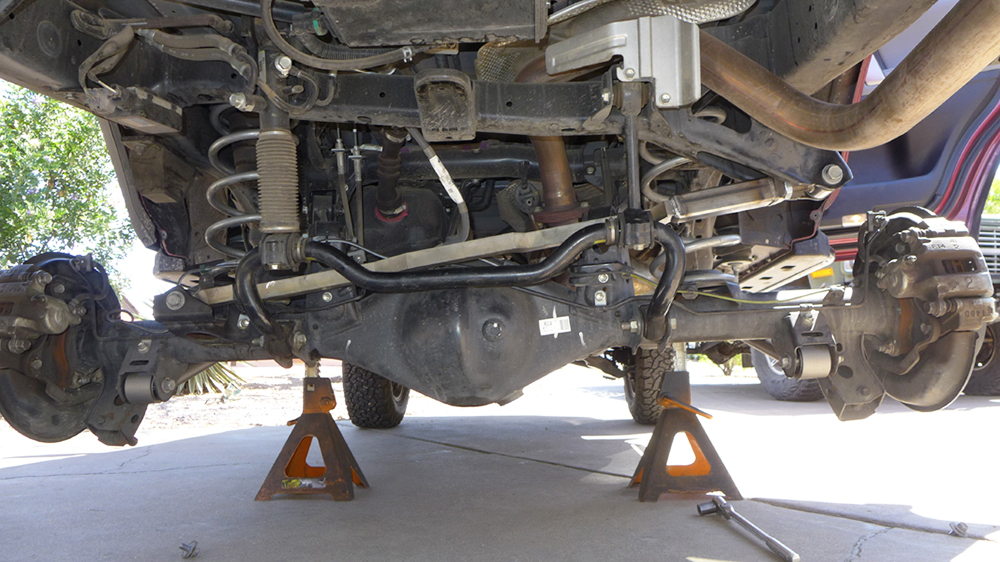![]()
ICON 2003-UP Toyota 4Runner Adjustable Rear Track Bar/pan hard bar ICON-54200
We were recently working on extending the brake lines on the 4Runner and noticed it.
There were marks on the track bar where the KDSS sway bar clamp bolt was making contact. After a few different thorough tests of the suspension’s travel, both up and down, it was apparent we had a problem.
I remembered back to a question about this track bar and whether it was needed or not for KDSS. From Icon documentation, I read yes, however, throughout the forum, you will read guys saying they did not need the track bar and had ZERO PROBLEMS.
After seeing the track bar was clearly contacting the KDSS sway bar, we needed something so I hit up Metal Tech 4×4 and ordered the track bar.
Icons track bar/ pan hard bar is literally designed with a bend in the bar to “clear” the passenger side mounts on the KDSS sway bar. Our problem was with the driver side sway bar clamp bolt, though.
The front clamp bolt on the driver side was making the contact with the track bar.
The KDSS Sway Bar Bolt Contacting Track Bar
![]()
Here, you can see one bolt on the bottom of the KDSS piston (KDSS Piston clamp bolt). The opposite bolt on the inside (facing the front of the 4Runner) was the culprit making contact with the track bar.
Upon installing the track bar, the mounting bolt is swapped out with an allen head bolt. This allows the KDSS sway bar to clear but then the actual sway bar itself made contact with the track bar causing us an entirely new problem with contact.
Long story short, the Icon-54200 track bar does not work for KDSS systems or at the minimum, it does not help prevent contact with the KDSS sway bar and the track bar.
If you are looking to get the most travel out of your KDSS suspension, then you should look at a different option.
The Icon track bar will at some point make contact on components of your suspension interfering and conflicting with the down-travel and up-travel.
There are guys out there with 2-3″ rear springs that claim it works for them (maybe on-road only?) but for the most part, everyone I have talked to personally with KDSS has had some complaint with the track bar making contact.
Not sure why this was something to debate about. I just have 2″ Icon rear coils with 2.0 aluminum shocks installed on my 2015 TE 4Runner with KDSS and the very first time I hit the road and rolled over a big bump at speed I made acquaintance with a loud metal clunk noise coming from the rear. How are you guys driving your vehicles? Like grandmas? I thought the whole truck was coming apart. The KDSS stabilizer bar was having a date with the factory track bar. Some guy on the forum.
If you are looking to push your suspensions travel to the max, you will need a better solution than the Icon track bar.
Axle Shift after a lift?
If you are looking to correct your axle-shift after your lift, then this track bar might be a viable option. After we measured the difference on both passenger and driver side, though, the axle was still about 1/2″ off. It looks like need to adjust another rotation. This was an after-thought to this whole install, though. The point was to clear the track bar of the KDSS lower piston bolt.
It may work for alignment correction as Icon states but it does not work for KDSS contact issues and you should avoid this track bar if you are trying to clear any components of your suspension, both in up and down-travel.
Track Bar Installation
- Price: $300+
- SKU: 54200
- Weight: 20.00 lb
- ICON Vehicle Dynamics: Check Today’s Price
The install was pretty simple. Just remove the factory track bar and swap in the new one.
This install assumes you know how to properly use jacks and jack stands. Start by jacking up your truck and removing your spare tire.
#1 – Remove factory track bar
![]()
#2 – Measure factory length at 40″
![]()
![]()
Lay the ICON track bar assembly over the stock track bar and adjust the end until the eye to eye dimensions are close to factory. The Icon track bar is exactly 40″ from eye to eye.
#3 – Grease Track Bar Bushings & Install Track Bar

Liberally grease the bushings and the drop them into place. Then tighten down the zerk fitting firmly.
#4 – Install new hardware
![]()
Remove front mounting bolt and replace with the new Allen hardware provided with the Icon Track Bar. Add some Loctite for good measure. This was the focal point of our original problem.
#5 – Adjusting Track Bar
![]()
Loosen the pinch bolts using a 3/8” 12pt. Using a 6mm allen, turn the collar 1/16th per 1″ of lift for axle-shift correction. With our 3″ spring, we rotated our collar 3/16″.
#6 – Tighten Track Bar Collar
![]()
Tighten down the pinch bolts using a 3/8” 12pt.
#7 – Track Bar Making Contact with KDSS Sway Bar
![]()
![]()
As you can see, the track bar is still making contact with the KDSS sway bar.
This was frame-supported, full droop with springs and shocks on.
#8 – Final for now
![]()
What are the other options?
Sonoran Steel Track Bar – KDSS

After posting something on Instagram, it led me to this track bar from Sonoran Steel.
The adjustable end is a huge 7/8″ -16 grade 8 threaded rod into a tube adapter made by Ballistic Fab in Tucson, hollow end of the bar is 1.5″ x 1.5″ x .120 wall Cold Rolled Square Tube, finally the same bushing setup as the other end. Finally, the part is painted with STEEL-IT® super corrosion resistant paint. The bar will run rear shocks 1.5″ longer extended than anything currently offered off the shelf for a 5th gen 4Runner.
What’s cool about this set-up is that Sonoran Steel and Radflo have a rear kit that was specifically designed for the 5th Gen 4Runner with KDSS.
Radflo supplies the custom-made (for this exact set-up) extended travel 2.5 shocks while Sonoran Steel provides the Track Bar and a set of beefy lower links.
Directly from Sonoran Steel:
This is all the equipment needed to open up the articlation with a KDSS rear axle on a 2010+ 4Runner.
It’s pretty tempting to just buy the whole kit and be done with it.
PCK (Panhard Correction Kit): Weld-on Bracket
![]()
This is another option but the major downside is that this bracket is a weld-on kit.
From what it looks like on their website, there are no actual 4Runners with KDSS running this kit.
So until then, I will probably look back at the Sonoran Steel option and go that route.

I just came across a product from blackgate customs that drops the sway bar by way of a machined shim. Seems like a solid solution for the problem this article showcases.
Keep in mind that this product is for rear suspensions that have a certain length shock… Don’t quote me, but I think that’s 25″…. SOLID product, not sure if it would/would not address the issue in this case
Love my Sonoran Steel kit.
FYI I know very little about Icon products as that is not a company I deal with. So I am not bashing anything, or anything like that, I just have no knowledge of what they do or how their products are designed because we do not deal with them. So sorry I can not shed any light there, don’t know the product line. I can only answer questions about Sonoran products that I actually make myself or Radflo shocks.
If Icon made the rear shocks the same extended length as stock, then you will not have an issue. Your also not going to have any added articulation. The rear Bilstein 5100 is 1″ longer than stock and the Custom Radflo Reservoir shock we have designed is 2.25″ longer then stock but still retains the stock compressed length. A truck with our setup will greatly out articulate, 2.25 at the shock more at the tire, then a truck with stock length rear shocks. Brenan has purchased out bar and I am sure he has installed it. There are bolt on replacement parts and then there are bolt on replacement parts that actually add travel.
Damn guys, well ok then. Maybe the 3″ spring makes the difference? This is pretty odd. Regardless, we bought the Sonoran Steel track bar. Hopefully, Steve (Sonoran Steel) can shed some light on exactly why/where contact is met.
Im with Jay on this. I too have the Icon Track bar that I bought with my Stage 2 since Icon recommended it. I have KDSS and I noticed no contact or hitting during on and off road driving. Even driving at 30-40 mph on dirt roads with high bumps, my front skid would hit the road and not the track bar hitting the kdss. I didn’t install the bar myself so I don’t know if the settings on the bar are altered or not to make it not hit.
After reading this I went out and checked my Icon track bar on my 2012 runner with KDSS and I don’t see any signs of rubbing. I’ve pushed the suspension plenty enough and while I do get odd sounds from the suspension from time to time I’ve never heard any metal on metal sounds from the rear. My runner has an Icon Stage 2 lift.
Jay, good to know. No marks on the track bar? Nothing out of the ordinary on up or down travel? Track bar clear sway bar on down travel and the diff on up travel?
Nothing dude! I crawled under and inspected all over that track bar and not a mark. I haven’t physically watched the track bar during suspension flex but if is was hitting I’d hear it or see marks.